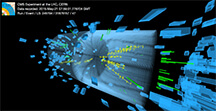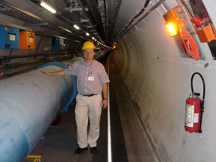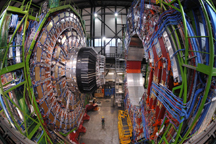Purdue professors, students part of record-breaking collider restart
June 5, 2015
 |
|
One of the first collisions in the CMS detector at the record-high energy of 13 TeV, taken during testing for the second run of the Large Hadron Collider in late May. (Image: CMS/CERN). |
WEST LAFAYETTE, Ind. — Scientists have restarted the Large Hadron Collider at CERN in Geneva, Switzerland, and on Wednesday (June 3) began to record data from particle collisions at a record-high energy.
During this second phase of data collection at the Large Hadron Collider, in which it will run at an energy level of 13 teraelectronvolts, an international team of scientists will search for dark matter, delve into the details of the Higgs particle and seek a greater understanding of our universe.
Purdue University's particle physics group has been among the team of international scientists working on the experiments at the European Organization for Nuclear Research, or CERN, laboratory for more than two decades. In July 2012, their work culminated in an historical moment when representatives of the international collaboration announced the discovery of the Higgs particle, and another when François Englert and Peter Higgs won the 2013 Noble Prize in Physics for their work in developing the theory of the Higgs field.
 |
|
Purdue physics professor Norbert Neumeister stands next to the Large Hadron Collider at CERN. (Photo courtesy of Norbert Neumeister) |
The Large Hadron Collider, or LHC, was turned off in 2013 and underwent two years of maintenance and upgrade work, said Norbert Neumeister, a professor of physics at Purdue who is a member of the collaboration. Neumeister has been at CERN since January working on preparations for data capture and analyses of runs at 13 teraelectronvolts. The higher energy collisions provide unprecedented opportunities for discoveries, he said.
"In its first run, the Large Hadron Collider only ran at half of the energy of which it is capable and a tremendous discovery was made," Neumeister said. "Today we started achieving collisions at an energy that will allow us to search for new particles and new phenomena not described by the Standard Model of particle physics. The data achieved could provide insight into important questions about the elementary constituents of matter and the fundamental forces that control their behavior at the most basic level."
In addition to Neumeister, professors within Purdue's Department of Physics and Astronomy involved in the LHC experiments at CERN include Virgil Barnes, Laszlo Gutay, Matthew Jones, Andreas Jung, David Miller and professor emeritus Arthur Garfinkel. Graduate students currently involved in the research include Kurt Larson, Greg Neeser, David Silvers and Alexey Svyatkovskiy. Many other graduate and undergraduate students and postdoctoral researchers have been involved in the experiment.
If new particles can be produced at these energies, then they are likely to be discovered early in the run, said Jones, an associate professor of physics.
"If we cross an energy threshold going from the 8 teraelectronvolts of the past run to the current 13, then we may start producing particles that we couldn't before," Jones said. "If this is the case, we would likely know it within the year. However, even if we don't see new particles, the higher energy will allow us to make more precise measurements, including for example, properties of the Higgs boson which will allow us to more fully understand its characteristics."
 |
|
The CMS detector. (Photo courtesy of CERN/Maximlien Brice) |
The Purdue team works on the Compact Muon Solenoid, or CMS, experiment at the LHC. The CMS is one of three detectors at the LHC capturing traces of collisions between protons as they are flung together at nearly the speed of light. Together with the ATLAS experiment, the CMS experiment is credited with the discovery of the Higgs boson, which provides a mechanism for subatomic particles to obtain mass and was one of the last pieces of the Standard Model of particle physics to be experimentally proven.
Purdue scientists and students contributed to the design and construction of several key parts of the CMS detector, the software used to operate it and analyze the collisions, and to a variety of key data measurements and analyses.
Barnes and Gutay contributed design features to two major components of the detector: the Hadron calorimeters, which detect showers of particles coming from high energy quarks; and the Muon detectors, which detect heavy relatives of the electron, respectively.
Neumeister, in collaboration with Purdue's information technology group, also contributes to the global distributed computing system that analyzes data from the experiments. The Purdue CMS "Tier-2" data storage and processing center is the largest of its kind among U.S. universities.
The Purdue team will analyze data from the second run of the LHC and is part of a project to upgrade the CMS detector.
CERN is the world's leading laboratory for particle physics. The Department of Energy's Office of Science and the National Science Foundation provide support for U.S. participation in the CMS experiments. Fermi National Accelerator Laboratory is the host laboratory for the U.S. contingent on the CMS experiment.
More information about the CMS experiment is available at http://cms.web.cern.ch/ and http://www.fnal.gov/pub/science/particle-physics/experiments/lhc.html
Writer: Elizabeth K. Gardner, 765-494-2081, ekgardner@purdue.edu
Sources: Norbert Neumeister, nneumeis@purdue.edu
Matthew Jones, 765-496-2464, jones105@purdue.edu
Link to Fermilab press release: http://www.fnal.gov/pub/presspass/press_releases/2015/LHC-Run-II-20150603.html
Link to CERN press release: http://cms.web.cern.ch/news/cms-embarks-data-collection-13-tev
Links to video: Higgs boson: a quick review for LHC Run 2 https://www.youtube.com/watch?v=0bwUaaHHFIY
Large Hadron Collider Run 2: Why higher energy? https://www.youtube.com/watch?v=ZTu2oK0TwO8
Related news releases:
Theory of Higgs field earns Nobel Prize, Purdue physicists part of experiment that proved it.
Purdue physicists part of discovery of new particle that could be Higgs boson
Purdue physicists pursue Higgs boson; part of international CMS experiment
Purdue scientists, students help create a key piece of one of the world’s most powerful cameras
Purdue physicists part of discovery of rare particle decay predicted by the Standard Model

